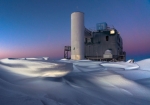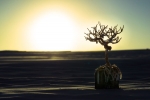Friday, April 21, 2017 - 12:00pm
Last week’s photos from the Pole were full of blue and green. The first visible auroras were out, and they appeared as bright green swaths and swirls against a blue sky. A bright full moon and Jupiter as a tiny speck also made appearances. Caption
Monday, April 17, 2017 - 3:30pm
Another amazing week at the Pole—not only was the detector performing well but the twilight photographs continued to be stunning. IceCube winterover Martin captured another great time-lapse shot of a NOAA weather balloon launch along with some striking images of the station and the IceCube Lab.
Friday, April 7, 2017 - 12:30pm
The sun has set, they’ve held their traditional sunset dinner, and yet … it’s still light outside. Well, that’s twilight. Even after the sun falls below the horizon, the scattering of light in the upper atmosphere illuminates the lower atmosphere and the Earth’s surface.
Thursday, March 30, 2017 - 10:30am
This photo at sunset is a picture that paints a thousand words, reminding us that the South Pole is technically a desert. The windswept snow forms into sastrugi, or sharp, irregular grooves and ridges on the hard snow surface. They can create interesting shapes and take on strange appearances, sometimes looking a bit like waves crashing to shore.
Monday, March 27, 2017 - 10:45am
Pull up a chair—sunset at the South Pole takes weeks, not hours. And why is that? Because the Earth’s rotational axis is tilted, the poles gradually proceed from full exposure to full shadow (and back again) as the Earth travels around the sun.
Friday, March 24, 2017 - 12:00pm
The fourth edition of the IceCube Masterclass hosted over 200 students at 14 institutions in Belgium, Denmark, Germany, and the US. Stony Brook University, which joined the masterclass program for the first time, had a full program for women. The positive interaction with scientists is again one of the things that students value most from this program. The masterclasses were held on March 8, 11 and 22.
Friday, March 17, 2017 - 12:15pm
A tree grows at the South Pole. Well, not really. It’s not an actual tree (rather, a sculpture made of copper), and it’s definitely not growing. But it looks like a tree—great photo!
Tuesday, March 14, 2017 - 3:30pm
Up until almost the last minute, the summer activities at the Pole kept the IceCube crew busy. This summer, a dozen IceCube researchers and staff, from eight institutions and six countries, spent some time at the Admundsen-Scott South Pole Station to perform maintenance and operations for IceCube and help prepare for a future deployment of the Askaryan Radio Array (ARA) detector. A PolarTREC teacher, Kate Miller, also traveled to the Pole to join the team, contributing to an extensive educational and outreach program that is still in progress. Caption
Friday, March 10, 2017 - 12:30pm
It was rather overcast last week. In fact, in this photo of the IceCube Lab (ICL), it’s almost hard to tell where the snowy landscape ends and the cloudy sky begins. This view of the ICL is from the vantage point of the geographic South Pole.
Tuesday, March 7, 2017 - 1:45pm
Last Friday, over 150 Spanish speakers came out for a science night in Spanish at the planetarium of the Madison Metropolitan School District (MMSD). The evening, hosted by the planetarium and WIPAC through the program “El Universo es Tuyo,” offered an appealing program: a planetarium show about the moon, activities with IceCube, science books in Spanish from the Madison Public Library, and several hands-on activities to learn about moon craters and eclipses run by UW Space Place and MEChA of UW–Madison. There were even some refreshments, through the generous support of Rocky Roccoco, Chocolate Shoppe Ice Cream, Woodman’s Markets, and Pick ’n Save.










